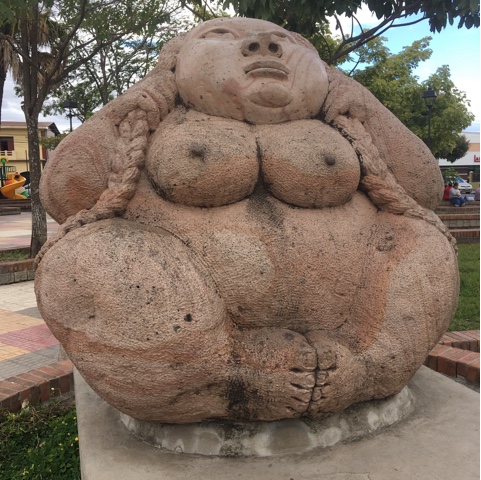El Brujito, the Shaman emblem of Esteli, Nicaragua
Okay Blogger Boy, try to do a complete post without mentioning cigars. I dare ya, I double-dog-dare ya! Challenge accepted you rotten voice-in-my-head. (Psst... They're reading this. Oh, right, sorry. Ahem.)
Villa de San Antonio de Pavia de Esteli is the full name of Esteli. Through the town runs a river of the same name. On the far side of the river, folks discovered a series of prehistoric petroglyphs chipped into large rocks. One of these, now named El Brujito, was adopted as the official emblem of the city of Esteli.
The Fat Lady ain't singing.
Another of the petroglyphs was the basis for this sculpture, located in the very fine central square. The square is the site of food vendors, lounging locals, and kids frolicking on the playgrounds. This is the spot from which to start any good Esteli walkabout. Located less than one hundred meters from the infamous Hotel Los Arcos, I crisis-crossed the square on most of my outings.
Esteli is situated in the northwest portion of Nicaragua, near the border with Honduras. It shares a political and cultural legacy with the liberal faction of the north, as opposed to the conservative faction of the south. It is another part of the Leon versus Granada history that has caused the country grief. During the Sandanista Revolution, grief came to Esteli in a big way.
The Battle for Esteli
In 1978 and 1979 there was heavy fighting in and around Esteli. The forces of the government, the Somocistas, were fighting against the revolutionary Sandinistas. The Somocistas, the conservatives, were fighting to maintain the dictatorship of Antonio Somoza. They held a particular animosity for Esteli, which they considered a hotbed of insurrection. The city was shelled with artillery, bombed from the air, and assaulted with infantry. Over the course of the hostilities, about 15,000 people were killed. This includes young men who the Somocistas massacred, based on suspicions that they supported the revolution. Following the eventual victory of the Sandinistas, the city was rebuilt.
Ash Wednesday in Esteli
Esteli is a busy town. There are a great many jobs involving the industry that we will not name in this post. As a result of those worker's wages, Esteli is a thriving, busy, noisy mercantile center. Loudspeakers blare from shops, hawkers sell their wares on the street, and workers look for bargains in bins of clothing. It is all noise and color and frenetic energy. Venture off into the side-streets, however, and Esteli is a place of narrow lanes and sleeping dogs.
The Esteli River, dry as a bone.
If you like chicken, rice, and beans, you will love Esteli. Nicaraguan cuisine is not one that folks usually rave about. That you will get plantains with every meal is a given. Let's be kind and call the local grub earthy. Yes, that's it, earthy. And filling.
My favorite street-food stall.
Pollo, hand-made tortillas, pico de gallo, and a smidge of slaw. What else do you need?
Still hungry? Heavy, sugary pastries are but a stone's throw away.
Speaking of the shops in Esteli, you may see someone wearing a T-shirt emblazoned with "New England Patriots -- Super Bowl Champions 2018." Wait, that's not right. But the Third World is where rejected clothing goes on to have new life. I have seen farmers in Laotian rice fields sporting shirts celebrating a Texas family reunion. How did such a shirt find its way here? The answer is simple: bulk clothing brokers. These folks buy up whatever rejected clothing they can find. The super bowl shirts printed for the losing team are a fine example. Bought for pennies a pound, the clothing, towels, whatever, are baled and shipped to other markets. Whole shipping containers of these bales end up in poor countries around the globe, where they are sold to folks who need cheap shirts.
Bales of forgotten First World goods.
There is one reason why folks in Esteli are able to buy goods, and that one reason is the industry we are not mentioning in this post. The current population of Esteli is estimated at about 130,000 people. That is the polulation of the town. The department, or state of Esteli, is somewhere in the neighborhood of 230,000 people. In the city of Esteli, about half of the folks are directly employed in one industry. That industry makes you-know-what. Virtually every other business in the town provides goods, services, or material to that same industry.
An evening walkabout can yield amazing sights. The gloaming of the day on a quiet Esteli street becomes, for a magic moment, a tableau of glowing red. Uniformed school children make their way home to dinners sure to contain a plantain. I stand mesmerized in the fleeting glow.
It is a pretty cool town. And I finished the post without mentioning you-know-what. Take that evil-voice-in-my-head. Until next time, and more of Nicaragua, Ciao for Now.










No comments:
Post a Comment